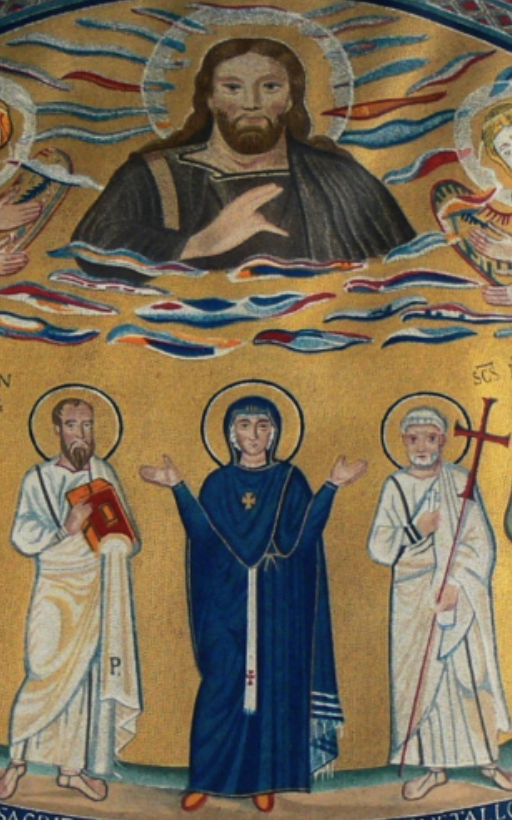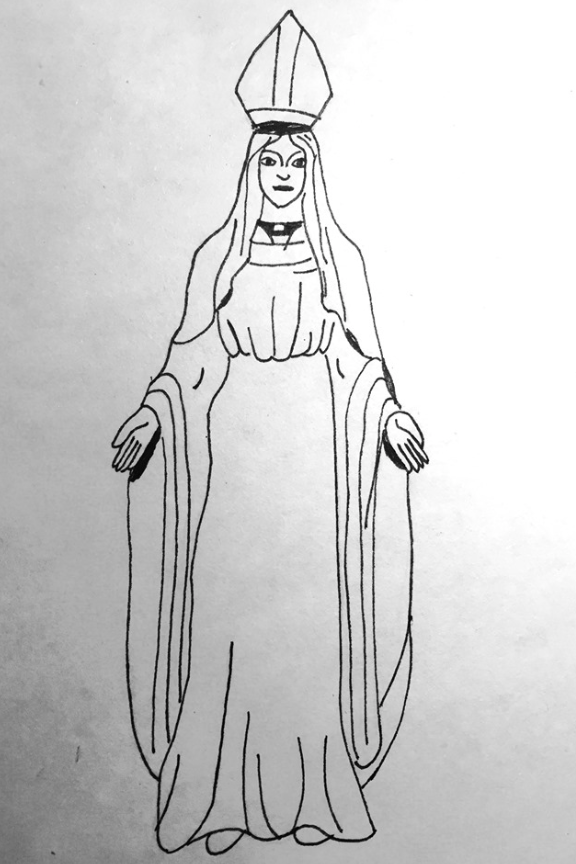The Priesthood of Mary and the Early Church
As Catholics, we might think that we know all there is to know about Mary. We wouldn’t have Christmas without her, after all. Mary’s backstory is sprinkled throughout the liturgical calendar, from the Immaculate Conception to the Annunciation to the Visitation, culminating on the day when she brings God into the world.
Upon reflection, though, we might realize that our Christmas ideas about Mary are pretty simplistic. She’s always “pure and lowly,” obedient, virtuous, and two-dimensional, always defined by the paradox of her virginity and motherhood. She probably doesn’t have lines in the Christmas pageant. Whoever wrote “Mary Did You Know?” apparently hadn’t read the Magnificat – Mary knew all along! We might start to realize that we don’t know very much about Mary after all.
This fall, I took a course called “Mary in the First Millennium” as part of my Master of Divinity degree at Union Theological Seminary. We learned all sorts of stories about Mary that would be completely unfamiliar to most people today. Some of the non-canonical texts that we read were just as popular as the canonical Gospels during the first few centuries of Christianity. The Protevangelium of James, for instance, tells of Mary’s miraculous childhood in the Jerusalem Temple, where she was sequestered from an early age to protect her purity and ate food from the palm of an angel. In the seventh-century Gospel of Pseudo-Matthew, we learn the details of the Holy Family’s flight to Egypt. When dragons and wild cats accost them, the infant Jesus (already capable of walking and talking like an adult) protects his parents and tames the beasts. We read non-Christian texts, too: the Qur’an gives us more details about Mary than any of the canonical Christian Gospels. During childbirth, a date palm showers her with fruit to eat.
One detail that might surprise contemporary Catholics is that Mary has been depicted as a priest in Christian art and literature since the church’s earliest years. Inspired by such representations, I decided to do my final project about what Mary’s priesthood means for today’s activists for women’s ordination. The answer? It’s complicated.
It’s tempting to retrieve Mary as a feminist exemplar for our cause. We need role models, after all. We have inherited an ancient and messy tradition and we’re hungry for the suppressed histories that can support our convictions. At the same time, though, it’s dangerous to say, “Mary is a feminist example” or “the early church was totally feminist!” It’s tempting to rally around romantic ideas of the past, but they’re easy to discount. If a quick internet search can debunk your argument (or at least complicate it), it’s vulnerable to attack from your opponents.
Mary’s priesthood has meant many things to different Christian communities. The intentions of an artist or author weren’t necessarily liberative: they might reinscribe sexist norms (Mary sometimes gets close to the Eucharist but can’t actually act of her own accord – early writers like Andrew of Crete call her body the Eucharistic altar!) or even support anti-Jewish theologies (Mary often symbolizes the new priesthood of the New Testament, which came to replace the corrupt priesthood of the Old Testament).
Mining early church history for
feminist exemplars requires care and nuance, but it’s still worth doing. The
Vatican’s interest in censoring Mary’s priesthood is evidence enough that the
symbol has subversive potential: “In 1916, the Holy Office actually forbade
depiction of Mary in priestly vestments. In 1927, further discussion of the
issue was curtailed to avoid misleading ‘souls not enlightened.’”[1]

[1] Cleo McNelly Kearns, “Eucharist and Ecclesia: Mary as Temple of the Temple,” in The Virgin Mary, Monotheism, and Sacrifice (Cambridge: Cambridge University Press, 2008), 283.
Ally Kateusz, a scholar at the Wijngaards Institute for Catholic Research, recently published Mary and Early Christian Women: Hidden Leadership (the ebook is available for free through the publisher). Kateusz’s book includes this seventh-century mosaic, which depicts Mary in a scene from the non-canonical Six Books Apocryphon. Mary stands between Peter and Paul, directly below the risen Lord. Her central position suggests her direct line to Christ, closer than even the greatest apostle. Her hands are raised in the orans position, a gesture of intercession, prayer, and even liturgical leadership. She wears a white strip of cloth called a pallium that typically represents a bishop. Kateusz proposes that the Vatican has deliberately covered and perhaps even censored this image because of its subversive potential.[2]
[2] Ally Kateusz, Mary and Early Christian Women: Hidden Leadership (Cham: Palgrave Macmillan, 2019), 81-89.

That said, the mosaic’s creator may or may not have wanted to make a statement about actual women’s liturgical leadership. We should be careful to avoid anachronism: Mary depicted as a symbolic priest doesn’t mean that communities would understand her as a literal priest, especially since the priesthood as we conceive of it today did not actually exist in the earliest centuries of the church. Scholarly opinion is divided about how these images were understood by ancient Christians. At the same time, though, Mary’s priesthood is a destabilizing image to today’s viewers. It disrupts our assumptions about which bodies should occupy powerful positions.
This Christmas, then, why not depict Mary in priestly vestments in defiance of that 1916 rule? Why not tell some unfamiliar ancient stories about her? You won’t like everything you find, but you might learn something that will help you see Mary in a new light. It’s easy to retell the same old stories with the same old tropes, but the history of Christianity is much more diverse and complicated than most of us can imagine.
Want to learn more?
Kateusz, Ally. Mary and Early Christian Women: Hidden Leadership. Cham, Switzerland: Palgrave Macmillan, 2019.
McNelly Kearns, Cleo. The Virgin Mary, Monotheism, and Sacrifice. Cambridge: Cambridge University Press, 2008.
Shoemaker, Stephen J. Mary in Early Christian Faith and Devotion. New Haven: Yale University Press, 2016

3 Responses
Wonderful work, a real Christmas gift!
What a wonderful, informative post, Abby. I am so glad the WOC board members are adding their insights and scholarship to the blog!
Thanks so much for the scholarly nuance of this reflection. I love it.